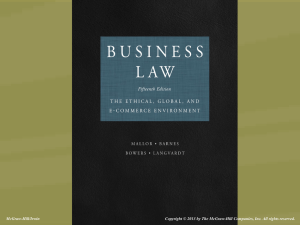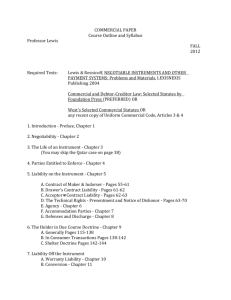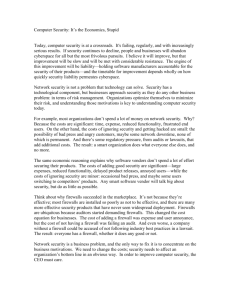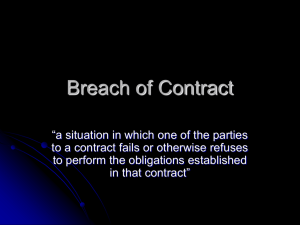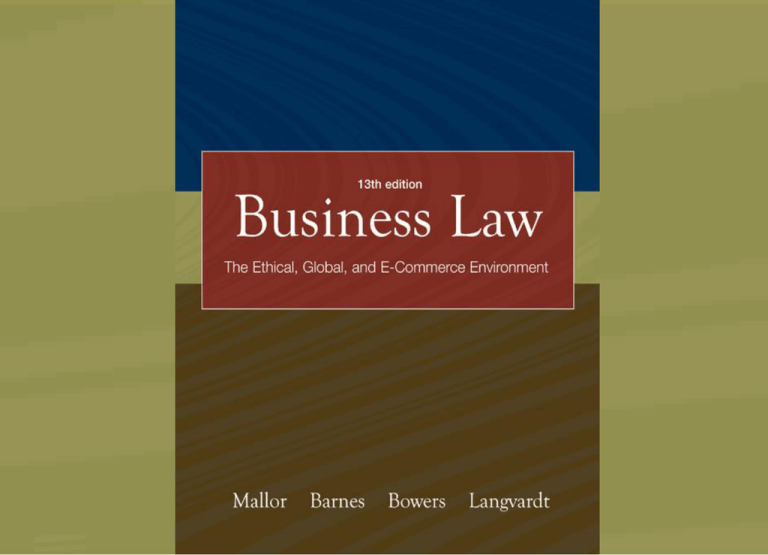
P A R T
7
Commercial Paper
Negotiable Instruments
Negotiation & Holder in Due Course
Liability of Parties
Checks and Electronic Transfers
McGraw-Hill/Irwin Business Law, 13/e
© 2007 The McGraw-Hill Companies, Inc. All rights reserved.
C H A P T E R
33
Liability of Parties
“Always do right. This will gratify some
people, and astonish the rest.”
Mark Twain, speech to Young People’s Society (1901)
Learning Objectives
The
Basics of Contractual Liability
Contractual Liability in Operation
Warranty Liability
Other Liability Rules
Discharge of Negotiable Instruments
33 - 4
Overview
When a person signs a negotiable instrument
as maker, drawer, or indorser, the person is
contractually liable to pay the instrument
Liability also arises from:
33 - 5
(1) improper transfer or presentment of an
instrument; (2) negligence in instrument
issuance, alteration, or indorsement; (3)
improper payment; or (4) conversion
Details of Liability
The maker or drawer of a promissory note is
primarily liable for paying the debt
UCC Article 3 requires a person who is
secondarily liable to pay the instrument only
if the person primarily liable defaults
An indorser usually is secondarily liable
A drawee has no liability on a check or draft
unless it certifies or accepts it
33 - 6
Presentment
Holder of a note may present it to maker on
or after the date payable
Dishonor: maker fails to pay amount due
Since maker is primarily liable, holder of the
note may demand payment from person with
secondary liability
To obtain payment or acceptance on a draft
or check, holder must present it to drawee by
any commercially reasonable means
33 - 7
Warranty Liability
Person who transfers negotiable instrument
or presents it for payment may bear liability
from implied warranties:
33 - 8
Presentment warranties: Warrantor/transferor is
entitled to enforce draft or authorized to obtain
payment, draft has not been altered, warrantor
has no knowledge of an unauthorized signature
Transfer warranties: Transferor gives warranties
to immediate transferee related to authenticity
and enforceability of instrument
Other Liability Rules
Mistake: Revised Article 3 follows general
rule that payment or acceptance is final in
favor of a holder in due course or payee who
changes position in reliance on payment or
acceptance; bank bears burden of mistake
Conversion: Revised Article 3 provides that
the law applicable to conversion of personal
property applies to instruments
33 - 9
Other Liability Rules
Negligence: Person who writes a negotiable
instrument to invite alteration may not use
alteration or lack of authorization as reason
for not paying an innocent holder [3–406]
Imposter rule: If an impostor convinces the
drawer to make a check payable to imposter,
any indorsement “substantially similar” to
that of named payee is effective [3–404(a)]
33 - 10
Other Liability Rules
Fictitious payee rule: Any indorsement in the
name of a fictitious payee is effective as
payee’s indorsement [3–404(b), (c)]
Protects person that pays instrument in good
faith or takes it for value or collection
Fraudulent indorsements by employees: Risk of
loss for fraud by employees entrusted with
negotiable instruments falls on employer
rather than bank that pays check [3–405]
33 - 11
Discharge of Obligor
Discharge from liability occurs
by payment, cancellation, or
alteration of the instrument;
modification of principal’s
obligation that causes loss to
surety or impairs collateral;
unexcused delay in presentment
or notice of dishonor of a check;
or acceptance of draft by a bank
33 - 12
Test Your Knowledge
True=A, False = B
33 - 13
When a person signs a negotiable instrument
as maker, the person becomes contractually
liable on the instrument.
The maker of a promissory note is
secondarily liable for paying the debt.
A drawee has liability on a check or draft the
moment it is presented for acceptance.
Test Your Knowledge
True=A, False = B
33 - 14
An indorser is not discharged from liability
until the instrument is presented for payment
or acceptance.
A person who transfers a negotiable
instrument or presents it for payment may
incur liability from implied warranties.
A person who indorses a negotiable
instrument usually is secondarily liable.
Test Your Knowledge
Multiple Choice
Norbert worked in payroll for Will Co. and
signed payroll checks. Norbert wrote a check
to Bradley Pitte, a fictitious employee, took it
to the bank with fake I.D., indorsed the back
with “Pitte’s” signature, and was paid in cash.
(a) The bank is liable for wrongful acceptance
(b) The bank is not liable under the common
law of conversion
(c) The bank is not liable under UCC liability
rules
33 - 15
Test Your Knowledge
Multiple Choice
Which of the following is not a transferee
warranty?
(a) Warrantor is entitled to enforce the
instrument
(b) The drawer has sufficient funds to pay the
instrument
(c) The instrument has not been altered
(d) All signatures are authentic or authorized
33 - 16
Thought Questions
What steps would you take to make sure
that the UCC rules concerning fictitious
employees and fraudulent indorsement did
not occur in your business?
33 - 17

